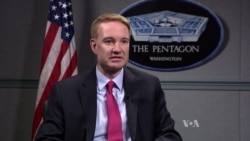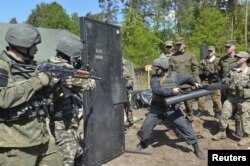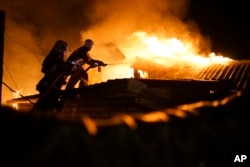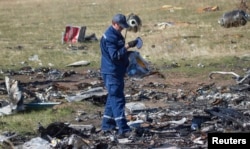Nearly two years after Russia’s annexation of Crimea, the territory remains under Russian control, and in the eastern part of Ukraine there has been an uptick in the fighting. VOA Pentagon correspondent Carla Babb discussed the issue with Michael Carpenter, deputy assistant secretary of defense with responsibilities for Russia, Ukraine and Eurasia.
VOA: Let's start with the European Reassurance Initiative. This was started in June of 2014, a few months after the annexation of Crimea. Now that budget has increased a lot — it's at, I think, $3.4 billion. Has this been effective to deter Russian aggression?
Carpenter: Well, I think the ERI, especially the increase, the quadrupling to $3.4 billion in fiscal year '17, is a testament to how seriously we take the threat from the East. And this is an investment in setting the conditions for effective deterrence and defense of our NATO allies, especially those on the eastern flank of the alliance. It'll involve a variety of different things, including an augmented rotational force posture in Europe, prepositioning of equipment, additional exercises, increasing readiness of our NATO forces as well as infrastructure investments, but the bottom line is this testifies to how seriously the United States takes the threat from the East for our NATO allies.
VOA: What, specifically, out of all those things that you've mentioned, what do you feel has been the most effective?
Carpenter: Well, deterrence and defense have to take place along various different levels of the escalation ladder, and they have to take place across various different domains — air, sea, land, et cetera. There's also conventional deterrence and nuclear deterrence. So it’s a multifaceted effort, and we're approaching this very much not only from a joint military perspective but, frankly, from a whole-of-government perspective. Because as we see some of the new hybrid toolkit that's being developed in Russia and elsewhere, it's incumbent for us and our allies to develop an appropriate response to that, and that's frankly a whole-of-government response and not just a military response. ... It's the combination. Look, I mean these various different threats — there's cyber threats, there's maritime threats, there's A2AD anti-access/area-denial threats, and so we have to be prepared to meet all of those and ensure that our NATO Article 5 collective defense commitment remains robust and sacrosanct, and we are very much committed to doing that.
VOA: [Lieutenant] General [Ben] Hodges, the head of U.S. Army Europe, spoke with VOA back in December, and he was talking about the Donbas region, saying that there is a chance to make some sort of agreement and to get some sort of solution there, but he said when it comes to Crimea, that's going to be a longer-term problem. So what can be done? The anniversary is going to be approaching soon. What can be done? What has been done by the United States to try to help Ukraine retake Crimea?
Carpenter: Well, look, clearly Crimea is a long-term problem, and we approach it from that perspective. We just celebrated last July the 75th anniversary of the Sumner Welles Declaration on nonrecognition of the Baltic states. That was a policy that we kept over many many decades, and I think our approach to Crimea is similar. But let there be no mistake: We view Russia's illegal attempted — and we refer to the term "attempted" because we don't care for any legitimacy on what Russia has done in Crimea — its attempted annexation is completely out of keeping with all norms of the international order — the inviolability of borders, sovereignty, territorial integrity — and we will maintain a robust nonrecognition policy going forward. Some of the sanctions that we have employed against Russia are specifically tied to the illegal attempted annexation of Crimea, and those will remain in place for the future.
VOA: There are some Ukrainians that watch VOA that would say that the longer-term problem [is that] the United States is giving up on Crimea. What would you say to that?
Carpenter: No, we're not giving up on Crimea. We recognize there was not a military solution to that problem, just as there is not a military solution to the problem in the Donbas. However, we have applied extraordinary diplomatic pressure over the course of the last two years, as well as economic sanctions pressure to deal with Russia's military intervention in Ukraine, and the combination of sanctions applied by the U.S. and our European partners, as well as, frankly, the drop in oil prices, has had a real detrimental effect on the Russian economy — not one which we are happy about, but one which is necessitated by Russia's actions in Ukraine.
Training effectiveness
VOA: Let's talk about the training, because that was one thing that VOA got a first look at — going into some of the training at the training center, seeing firsthand the U.S.-Ukrainian relationship. It's been a few months now, because we were there at the start of the training. Would you tell us what's been going on? Give us an update on the training. Has it been effective?
Carpenter: I believe the training has been very effective. We started our training program with the National Guard, which is subordinate to the Ministry of Interior, and we transitioned it in November to Ukraine's conventional armed forces as well as their special operations forces. Initial reports in the field indicate that the Ukrainians value the training they we’re providing. Our own assessments indicate that it's really having a breakthrough, not just in terms of having Ukrainians understand small-unit tactics and operational concepts, but it's fundamentally inculcating a new culture in the Ukrainian armed forces, which is so important for their defense reforms and the professionalization of the military going forward. So we think it's having a real effect, and we're going to continue with this training out into the future.
VOA: Have you noticed any improvement with some of the casualties from preventable blood loss? I know that was a huge issue in eastern Ukraine. Up to 40 percent of the casualties there were preventable if they‘d just have the right training for a medical attention. Have you been able to see any of these effects yet, or is it still too soon? Has it not been long enough to take effect?
Carpenter: I think we've seen, of course, the fighting has died down from what it was in August of last year, so we haven't seen the level of violence, although recently there has been an uptick over the last six weeks that's been considerable. But we haven't seen quite that same level of violence as we had in August, so it’s probably a little bit too early to tell whether all of our medical training has had the desired effect. But we're going to continue with this.
We have deployed a field medical facility to Ukraine as part of the training and equipment that we’ve provided. We’re also doing training in the medical arena, and so our hope is that this is going to have an effect on the tactics, techniques and procedures that they employ during those critical first hours after a soldier is injured. We see some success, but it sort of remains to be seen if this is a culture that is internalized and adopted over the long term.
Rise in violence
VOA: You mentioned the decrease in fighting since August. You also mentioned the recent uptick you have seen over the last few weeks. So give me more specifics. What's going on right now in eastern Ukraine?
Carpenter: Well, unfortunately, what we've seen over the course of the last six weeks or so is precisely an uptick in violence. We've seen on February 15th, we've seen Russian-backed separatists actually threatening to fire at OSCE monitors from the special monitoring mission. We've seen repeated incidents of access being denied to areas of the Donbas, where then later the OSCE is able to verify that in fact there are proscribed weapons in those areas. And we've seen, frankly, since the Minsk agreement was adopted a year ago, over 430 casualties among Ukrainian armed forces. So the cease-fire that has been in place since September has been a very imperfect one and increasingly so over the course of the last four, five, six weeks, which is a cause for concern.
VOA: What’s Russia's role in this? Are they still as involved as they once were? Do you still see any Russian activity?
Carpenter: Let me be very blunt on this point: Russia maintains command-and-control links over the separatists that it backs over in eastern Ukraine. We see Russia continuing to pour heavy weapons into the region. We believe that Russia still maintains a force presence inside eastern Ukraine and certainly trains and controls the separatists there in the Donbas. So this is a Russia-fostered problem. This is not some sort of spontaneously emerging problem in the Donbas, and it has been that way since the start of this conflict.
VOA: And so has that sparked additional assistance? Can you talk through a little bit about what the United States has done assistance-wise? What the numbers are right now dollar-wise?
Carpenter: Since the start of the conflict, the U.S. has provided $265 million in security assistance to Ukraine. And we have engaged in the training programs that I referred to earlier. This equipment has gone to — or this assistance, rather, has gone to — a variety of different types of equipment, from counter battery radars to night vision equipment, secure communications, vehicles, patrol boats. It's been a wide array of different types of equipment. The goal here is to make the Ukrainian forces more capable and able Ukraine to defend itself.
VOA: But still no lethal assistance?
Carpenter: We've done a lot, and thanks to Congress we have an appropriation for $250 million in additional security assistance to Ukraine. We have calculated from the beginning that the solution to the conflict in the Donbas is not on the battlefield but is precisely through diplomatic and economic [measures], meaning sanctions pressure. And we are fully committed to maintaining sanctions against Russia until the Minsk agreement is fully implemented — and I want to stress "fully implemented," which means that the border will be returned to Ukrainian control, the international Russian-Ukrainian border. So that has been our mode of leverage over Russia; that is the pressure that we have applied, together with diplomatic pressure. I think we have been very successful in galvanizing international support, particularly with our European partners. We have had to deploy our diplomatic engagements and attention frequently over the course of this conflict to ensure that the Europeans are with us. I think we've been very successful in that effort, and that will remain the case. We will continue, however, of course to provide security assistance to Ukraine, because as I said earlier, Ukraine has a right to defend itself. But I think the lethal equipment vs. nonlethal equipment distinction is not necessarily the right one for understanding what capabilities Ukraine needs going forward. We're here to train Ukrainian forces to make them more capable, including NATO interoperable over the long term. That's been our goal and that remains our goal.
VOA: But there are Ukraine commanders that would disagree, saying, "We need more equipment. We're going up against Russia; our army is just not that ready when it comes to such a big Russian threat." So how do you ... balance that?
Carpenter: Well, the reality is that over two decades, the Ukrainian armed forces were significantly hollowed out through corruption and through mismanagement, lack of attention, lack of resourcing. And so when Russia intervened militarily in Ukraine, the Ukrainian armed forces were not in a state where they could defend themselves capably. We have sought to rectify that. As I said we have a very robust training program in place, both for the conventional armed forces and for Ukraine special operations forces. We have advisers that we've deployed to advise the Ministry of Defense. We have worked through the joint multinational commission to promote defense reform within Ukraine's defense establishment, its general staff as well as its Ministry of Defense. So we have frankly done a lot, I think, to spur Ukraine capacity and capabilities to defend itself, and we're going to continue to do that. We are also enlisting the support of our allies, and we have a number of allies who participate in that joint multinational commission, which is very important. This can't just be a bilateral effort; this has to be an effort that is multinational, and we have been successful, I think, so far in multinationalizing that effort to spur Ukrainian defense reform and increase their capabilities.
Lethal aid?
VOA: VOA Ukraine has heard through some sources that the United States is considering providing lethal aid through other nations. Is there any truth to this?
Carpenter: No, I think you've seen we've been very transparent. We have sought to be transparent from the very beginning about the assistance that we've provided to Ukraine. So we are not engaging in any efforts to channel lethal aid through other countries.
VOA: Switching over to the topic of the MH17 flight that was shot down: There was a report just released recently by a group of independent journalists saying that they had used satellite imagery and social media to confirm that the missile that shot the plane down came from the Russian base and was transported by Russian troops. My question to you is: Where is the United States in this, and why are we not hearing more from the United States talking about how horrible this was to happen, and can the United States confirm this?
Carpenter: Well, look, we have been very forthright from the very beginning about this tragedy, in which over 300 souls lost their lives, and ... we have cooperated with the Dutch safety board in the investigation. ... They, in fact, released a report in October which confirmed what we have been saying all along, which is the MH17 was brought down by a Russian-produced missile that was fired from territory in eastern Ukraine that was controlled by the Russian-backed separatists. We came out with that information very early on, and that was corroborated by the Dutch safety board. Right now, there is a joint investigation team — it's a multinational effort to look into the causes of the downing of MH17 and hold those who are responsible accountable, because ultimately the goal here is to do justice in this case, in this terrible tragedy, and we have been fully supportive of the efforts of both the Dutch safety board and now of the joint investigation team.
VOA: Is the U.S. planning to put any sort of anti-missile defense system in or near Ukraine?
Carpenter: A missile-defense system in Ukraine? No. No.
VOA: And then, finally, I want to turn it toward the situation in Syria. The United States and Russia have been working together. We reporters have been watching a cessation agreement come into fruition. What happens now?
Carpenter: Right now we are focused on this cessation-of-hostilities agreement which you just referred to. We are going to test this agreement. We want to make sure that Russia abides by the agreement in terms of its deeds and not just words, and so this is frankly a moment of truth for both Russia and for the Assad regime. Will they comply with this agreement or not? We are not naïve; we are not hopeful without any cause. We are going to test this proposition and apply every effort possible to see whether we can have some sort of diminution in the level of hostilities which have claimed so many civilian lives over the course of this conflict.
Russian behavior
VOA: Analysts have argued that as Russia continues airstrikes, there's not a possibility for other groups fighting alongside to respect the cease-fire. What do you say to that?
Carpenter: Look, the battle space in Syria is very complex. There are numerous groups on the ground. These groups are often intertwined. ... It's a country that’s been in civil war now for a number of years. It is not an easy task to implement a cease-fire even locally, much less nationally, so this is going to be a very difficult process. But it will fundamentally depend on Russia's ability and the regime's ability to withhold support to elements on the ground that right now are seeking to gain additional territory. So it will be incumbent on Russia and the regime to not provide the air support and hold back their forces on the ground that right now are on the offensive. So again we have this agreement on cessation of hostilities. We are going to test the proposition [of whether it can be] implemented, but at the same time we’re going to look at deeds and not words and terms of implementation.
VOA: Has the United States spoken with Russia about the consequences if this cease-fire does not hold?
Carpenter: We have had extensive discussions with the Russians about this cessation-of-hostilities agreement, and we have impressed upon them that their intervention in Syria has only fueled the conflict there on the ground. It’s only resulted in more radicalization, and that will be the case over time as well. I think Russia knows what the stakes are. The question is, again: Are they willing to press the forces that they support on the ground to stop fighting?
VOA: Romania says that it wants to create a NATO fleet on the Black Sea permanently. I know that this is not your exact country — you don't cover Romania — but could you talk a little about how this is going to affect U.S.-Russia relations and whether or not the United States is having talks about [this subject]?
Carpenter: Well, what I would say is that we have right now a very low level of a maritime force posture in both the Black and Baltic seas, and it's something that we need to address. ... That said, the European Reassurance Initiative that I talked about earlier and the $3.4 billion is not focused on Black Sea augmentation but on other aspects of our force posture and the prepositioning [of] equipment in the eastern flank of the alliance. But we will have to look at the Black Sea. ... We do look at it as a strategic region in which we have both Turkey and NATO allies Romania and Bulgaria ... so we do have an interest in security in this region. But at the same time — and I want your viewers to understand this important point — that when we talk about the European Reassurance Initiative, we are talking about something that is fundamentally defensive in nature and proportionate to what Russia is doing, and that will continue to be the standard by which we look at all of our future augmentations of force presence and posture in the region.

















